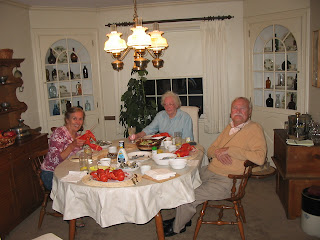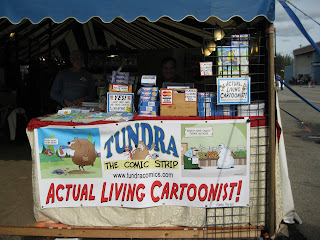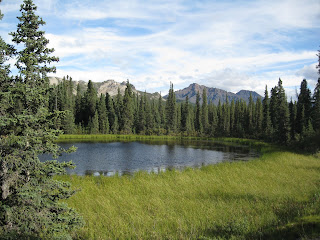I found an "old" friend in Barkerville.
Billy Barker's discovery of gold on Williams Creek in 1862 triggered a stampede of thousands of miners to the area over the next eight years. Many travelled by way of the Cariboo Wagon Trail which was the route we drove up when we first started our Alaskan Adventure in May.
Barkersville was a typical gold rush boomtown. Now it is a unique heritage site, and well worth the visit. There are over 125 heritage buildings and museums, and lots to do, including live stage shows, mining demonstrations, gold-panning, stagecoach rides, and historic tours of Chinatown.
Main Street in Barkerville.
David, visiting one of the many buildings in Chinatown.
From Barkerville we drove over to Bowron Lake Provincial Park. After days of driving we were looking forward to spending three quiet days kayaking on the lake.
We found a campsite and then walked around to get familiar with the park. David was feeling strong and healthy so he celebrated by doing 50 jumping jacks!
Our campsite at the Bowdon Lake Provencial Park.
Bowdon Lake beckoned to us.
The next morning we walked up to the Ranger Station to register since we planned to be out on the water for three days.
However, that was not to be... thwarted again.
David had been taking a powerful anticoagulant (Plavix) since his "cardiac event" and apparently the jumping jacks had caused internal bleeding. With a history of bladder stones and kidney stones, we could not ignore the blood in his urine. So we packed up and drove to the closest hospital, which was in Quenel. David spent the night in the ER hoping that the bleeding would stop. Fourteen hours later we were on our way to see the closest urologist. We spent two more days at the Regional Hospial in Prince George. We were well taken care of by the Canadian health care system.
We had been thinking about extending our trip to include Jasper National Park in Alberta, meet up with our friends at the Lazy Daze Rally in Idaho and end up at the 100th Anniversay of the Pendelton Round-up in Oregon. However, our focus had switched and we were eager to get home.
Upon discharge we high-tailed it to the border.
When we first started out on our Alaskan Adventure we saw young shoots of fireweed along the roadsides and in camping areas. As the summer went by, the fireweed came to full bloom. Now the flowers were spent, and the tall stems were topped with fluff and seeds which were carried off by the autumn breezes.
It felt like it was our time say goodbye to the summer too.
Fireweed, at the end of the season.
When we returned to Eugene we checked in with David's doctors and then settled in at the RV parking lot at RiverBend Hospital. He enrolled in the Cardiac Rehabilitation Program for six weeks and graduated with flying colors.
The main section of RiverBend Hospital.
There's our rig, next door to the hospital.
Behind the RV parking spaces there is a lovely path leading through a stand of old growth trees, to the edge of the McKenzie River. We walked it nearly every day and soaked in the energy of Nature.
This turned out to be a healing time for both of us.
A time for rest and reflection.
A time for renewal before our next RV adventure.
The path ... inviting us to keep moving.































































